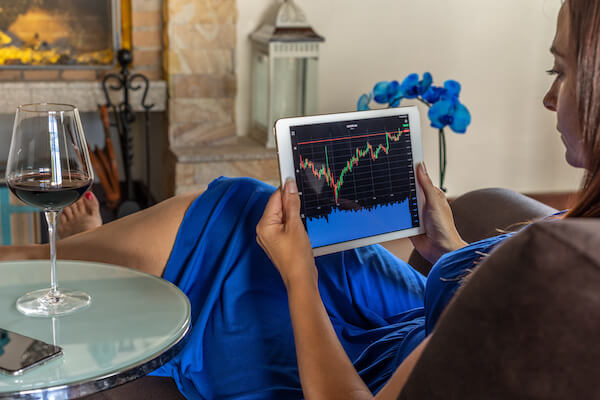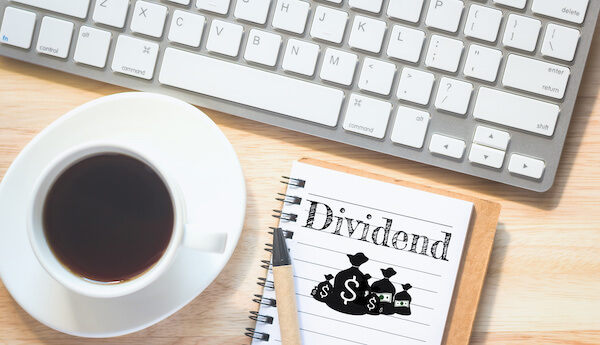
As you learn about investing, an inevitable question that comes up is: What are dividends? Many resources for investment advice will lay out graphs, percentages, and words like “qualified” and “tax-deferred.” But let’s take a route that’s a little more fun. Let’s use a wine metaphor.
Imagine a beautiful, sunny day strolling through a vineyard. The winemaker has nestled grape vines into the soil. Grapes are growing everywhere.
When it comes time to harvest, does the owner cut down the vines? Not a chance. The grapes are harvested, the wine is made, and the process begins all over again. That way, next year’s bounty is just as abundant.
The vines remain intact and continue producing grapes, wine, and money. Dividends work much in the same way.
Unfortunately, this is where we pause our discussion of wine. But making money ranks right up there, doesn’t it?
In this article, we’ll explain how that harvest is the perfect metaphor for answering the question “what are dividends?” We’ll also explore how dividends complement a well-diversified portfolio and walk through items you should consider before taking the next steps in becoming a dividend investor.
What Are Dividends?

When you own stock in a company, the cash you invest helps that company operate. In return for your money, some companies opt to pay a dividend. Dividends are essentially the company’s way of sharing a bit of their success with their stockholders.
If you’re wondering why companies pay dividends, you’re not alone. Sounds too good to be true for Corporate America. After all, corporations incorporate and operate in order to make money. They’re not exactly known for sharing, right?
But when more people buy a company’s stock, that’s creating demand. Demand tends to drive stock prices higher. So when a company pays a dividend, they’re sending out a signal. They’re basically broadcasting a message that says, “Our performance and cash flow are strong and our future looks bright.” It’s like flexing the financial muscles in a show of strength.
Not All Stocks Pay Dividends
If a stock doesn’t pay dividends, an investor will have to sell the stock in order to make a return on their investment.
Going back to our vineyard example, this would be like chopping down the vines and selling the grapes that way. Once you sell the stock, you no longer own it and obviously make no future money from that investment.
How Do Dividends Work?

Stocks that do pay dividends are referred to as dividend stocks. Just like in the vineyard example, when you buy a dividend stock, every so often it pays you a dividend. You continue to own the stock and it continues to provide fruit.
The company shares some of their success in the form of two types of dividends. Cash dividends or stock dividends. Cash dividends are awarded in — you guessed it — cash payments. And stock dividends are awarded in the form of additional shares of the company stock. Both types of dividends can be reinvested via dividend reinvestment plans.
The board of directors determines the dividend policy and the amount of the dividend. You’re awarded your portion of the company’s profits on a per-share basis. In other words, the amount of the dividend depends on how many shares of stock you own.
When understanding how dividends work, it’s also important to note a few caveats.
If the company becomes insolvent, investors need to get in line. There’s a hierarchy that determines who gets paid first.
Investors who own preferred stock get first dibs. Investors who own common stock come next.
Also, dividends are not guaranteed. The board of directors can decrease or even eliminate the dividend at any time. For this reason, it’s important to understand how the company is doing and whether they’ll be able to sustain the dividend payment for the foreseeable future.
Learning the Lingo
Now that we’ve covered the big-picture stuff, let’s get you armed with the lingo so you can really speak about and understand what dividends are.
Dividend Sustainability
Let’s talk about some terms that help you understand how sustainable the dividend might be.
Just like in our vineyard example, if the farmer is overzealous during the harvest, there might be a lot of wine to go around now. But the vines may be damaged in the process. This would be an indicator of the sustainability of future harvests.
When it comes to dividend stocks, if a company pays out too much in dividends now, it may not be equipped to maintain steady dividend growth. It may not even be able to maintain overall business growth.
Therefore, when you’re looking at dividend stocks, you need to look beyond just who is paying more per share.
Here are a few metrics that can help you do that.
Market Volatility
First, you should look at market volatility for the company. Look at the stock market overall, the industry, current events, and at the competitive landscape. Consider supply and demand as well as any potential disruptions that might be on the horizon. What you’re after here is gathering a holistic prediction of how well the stock might perform in the short-term and in the future.
Dividend Yield
Next, consider dividend yield. Dividend yield is calculated as a ratio. You take dividend payout per share and divide it by the stock price per share. The market considers a healthy dividend yield to be between 2% and 6%.
We can’t stop there. Why? Because the management of some companies can be tempted to inflate the dividend payout to attract shareholders and drive up the share price.
Payout Ratio
So to really understand the stock, one more metric becomes important. And that metric is the payout ratio. The payout ratio lets you really see what’s happening as far as company performance.
Payout ratio is calculated by taking the total dividends paid to stockholders and dividing that number by total net income. The market considers a healthy sustainable payout ratio to be between 30% and 55%.
Timing
Finally, let’s talk timing. There are several important dates you need to know when it comes to dividends.
- The declaration date occurs when the company’s board announces that it has approved the dividend payment.
- The record date occurs when you become a shareholder of record. This means you are now deemed eligible to receive the dividend payment.
- The ex-dividend date represents a sort of cut-off. It typically happens one day before the record date. It’s an important date to know since you need to own the stock before the ex-dividend date if you want to receive a dividend payment. Otherwise, you’re not eligible.
How to Get Started With Dividends

There are several ways to begin dabbling in dividend investing.
You can buy individual stocks. Many investors will begin by looking to the “Dividend Aristocrats,” which are quality companies with a proven track record of dividend growth.
Another option is to invest in dividend-focused mutual funds or exchange traded funds (ETFs).
When you find your groove, dividend investing can create a powerful stream of income. Plus, you have the potential to enjoy the appreciation of the stock price itself. And with dividend investing you have a pretty reliable insurance policy built in. Whether the share price goes up or down, you’re still collecting dividend income either way.
Learn More About Building a Dividend Portfolio
As you get started with dividend investing, be sure to think like a vineyard owner. Think not just about this season’s wine, but about the future.
Leave that principal investment untouched. Build a portfolio that’ll keep growing and paying dividends well into the future.
You should feel great that you’ve taken the important first step of getting an answer to the question, “What are dividends?” Now keep that momentum flowing and get yourself closer to financial freedom.
We’ve identified three dividend stocks we think you should buy and hold forever. To learn about them, subscribe to the Investors Alley “Dividend Hunter” newsletter.





